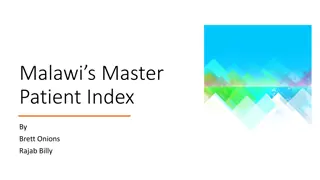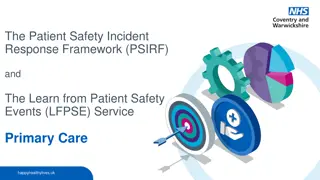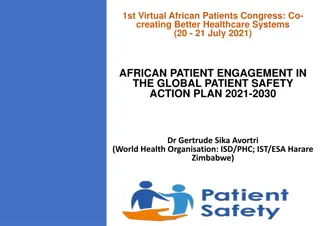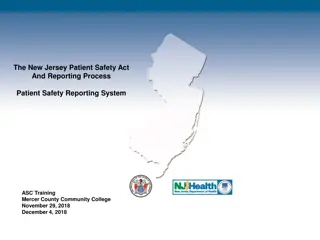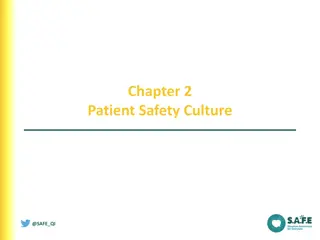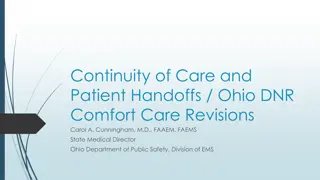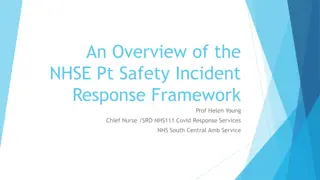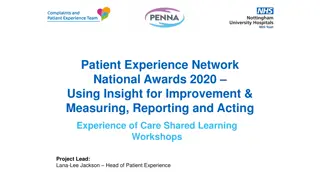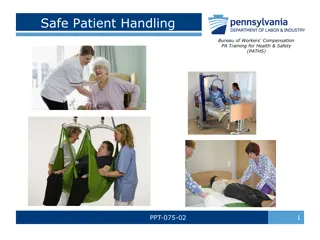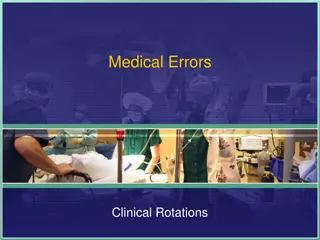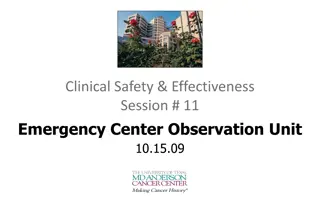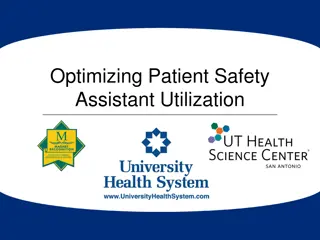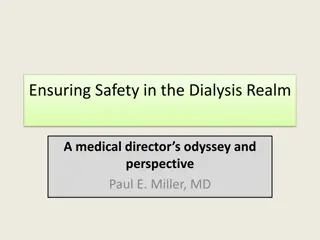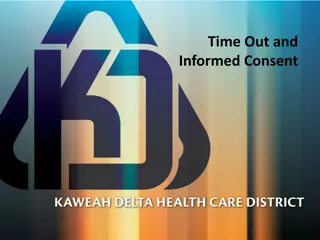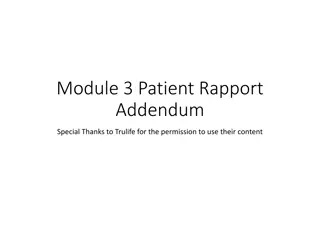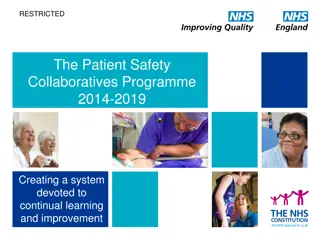Modernize Patient Experience with Digital Patient Conversion Platform
Enhance patient relationships and streamline your practice with a secure digital patient conversion platform. Acquire new patients online, modernize patient experience, retain existing patients, and optimize technology investments. Utilize tools like online booking, digital check-in, and workflow au
0 views • 31 slides
Medical Center Health System.
The Medical Center Health System (MCHS) emphasizes the importance of reporting patient safety events to improve the quality and safety of patient care. All team members are encouraged to report any deviation from routine care, events causing harm or potential harm, near misses, patient complaints, a
0 views • 4 slides
Understanding the Patient Safety Incident Response Framework (PSIRF)
The Patient Safety Incident Response Framework (PSIRF) is set to replace the Serious Incident Framework (2015) within the NHS, marking a significant shift in responding to patient safety incidents. Its key aims include compassionate engagement, system-based learning, proportionate responses, and sup
5 views • 9 slides
World Patient Safety Day 2023: Engaging Patients for Patient Safety
World Patient Safety Day 2023 emphasizes engaging, raising, advocating, and empowering patients for safety in healthcare. Major activities include taking the pledge of "First Do No Harm," promoting patient safety at Health Mela events, recognizing safety champions, and sharing innovative learnings.
6 views • 15 slides
Enhancing Healthcare Services in Malawi through the Master Patient Index (MPI)
The Master Patient Index (MPI) plays a crucial role in Malawi's healthcare system by providing a national patient identification system to improve healthcare quality and treatment accuracy. Leveraging the MPI aims to dispense unique patient IDs, connect with existing registries, enhance data managem
4 views • 8 slides
Rwanda HIE Patient Identity Management System Overview
The Rwanda Health Information Exchange (HIE) system focuses on patient identity management to uniquely identify individuals seeking healthcare across the country. By maintaining a set of identifiers in the client registry and avoiding duplication of patient records, the system ensures efficient and
12 views • 8 slides
Enhancing Patient Safety in Primary Care: PSIRF and LFPSE Overview
The Patient Safety Incident Response Framework (PSIRF) and Learn from Patient Safety Events (LFPSE) aim to improve patient safety by providing a structured approach to incident response and analysis in primary care settings. PSIRF emphasizes compassionate engagement, learning from incidents, proport
3 views • 14 slides
Enhancing Safety: People Power SafetySTEP Refresher Training
Explore the comprehensive SafetySTEP Refresher Training program aimed at achieving safety through employee participation, engagement, and proactive safety measures. This training emphasizes creating a culture where safety is a core value, utilizing leading indicators to measure safety successes, and
0 views • 65 slides
How to Add a Patient to a Custom Patient List in The New EPR
Learn step-by-step instructions on adding a patient to a custom patient list in The New EPR (Electronic Patient Record) system. Follow the detailed guide to efficiently manage patient data and create customized lists for easy access. Enhance your workflow with this quick reference guide.
0 views • 9 slides
National Mine Safety Week 2023 - Vehicle Safety Guidelines
Explore the comprehensive safety guidelines for vehicle operation during National Mine Safety Week 2023. Learn about maintaining safety equipment, cabin safety systems, visibility safety systems, operational safety systems, emergency safety systems, other safety systems, training responsibilities, a
1 views • 10 slides
Organising Nursing Services for Effective Patient Care
This content discusses methods of patient assignment, objectives of organising patient care units, factors influencing patient care quality, and considerations for organising patient care in wards. It emphasizes forecasting needs, professional activities, organizational activities, physical environm
0 views • 45 slides
Enhancing Patient Safety: Global Action Plan 2021-2030
Patient safety is a critical aspect of healthcare with millions of adverse events occurring annually. The Global Patient Safety Action Plan (GPSAP) for 2021-2030 focuses on key areas such as policies for zero patient harm, high reliability systems, safety of clinical processes, patient and family en
0 views • 13 slides
Role of Radiology Resource Nurses in Healthcare
In November 2018, the need for Nursing Coverage in the Radiology Department led to the identification of the Role of Radiology Resource Nurses (RRN). These critical care-trained Registered Nurses act as clinical liaisons between patient care areas and the Radiology Department, ensuring continuity of
0 views • 21 slides
Understanding the New Jersey Patient Safety Act and Reporting Process
The New Jersey Patient Safety Act, enacted in April 2004, aims to enhance patient safety, minimize adverse events, and improve system/facility performance. It emphasizes confidentiality, promotes a blame-free culture, and encourages evidence-based practices. Healthcare facilities, including ASCs, ar
0 views • 71 slides
Ensuring Patient Safety in Blood Transfusion Services: Standards and Concerns
Hospitals providing Transfusion Medicine services must adhere to established standards to ensure patient safety and product efficacy. Facilities not carrying a laboratory license but receiving blood components must also meet these standards. Lack of standardized policies poses risks to patient safet
0 views • 20 slides
Comparative Analysis of Aviation Safety Management Systems: MSG-3 vs. SMS
The aviation industry continuously strives to enhance safety, leading to the development of Safety Management Systems (SMS) by ICAO and the longstanding Maintenance Steering Group (MSG-3) program. These systems focus on improving safety through different approaches, with MSG-3 emphasizing engineerin
1 views • 25 slides
Understanding Patient Safety Culture and Its Key Characteristics
Patient Safety Culture is vital in healthcare organizations as it involves individual and group values, attitudes, and behaviors that influence safety commitment and management. The chapter delves into theories and approaches to fostering a safety-based culture locally, highlighting the importance o
0 views • 21 slides
Enhanced Recovery Program Implementation in Post-Surgical Nursing
Introducing and implementing an Enhanced Recovery Program (ERP) in post-surgical nursing can significantly improve patient outcomes, experience, and satisfaction. This clinical pathway designed by MSQC aims to optimize patient recovery by standardizing protocols throughout the perioperative care pro
1 views • 26 slides
Enhancing Patient Handoffs and Continuity of Care in EMS Settings
This document discusses the critical aspects of patient handoffs and continuity of care in emergency medical services (EMS) settings. It highlights the challenges faced during patient transitions and emphasizes the importance of effective communication and collaboration between EMS providers and rec
0 views • 14 slides
NHSE Patient Safety Incident Response Framework Overview
The NHSE Patient Safety Incident Response Framework (PSIRF) is a new system designed to shift from reactive to proactive incident investigation in patient safety. It promotes a just culture approach, prioritizes quality investigations, and emphasizes the engagement and support of patients, families,
1 views • 12 slides
Proactive Safety Measures: PDO Safety Stand Down April 2024
A Safety Stand Down is a crucial activity to proactively discuss safety with employees, emphasizing risk awareness and injury prevention. The incident involving a fatal injury during Rig Move activities serves as a catalyst for reflection and improvement regarding safety procedures. This guide provi
1 views • 4 slides
Improving Patient Access to Clinical Care in NYC Correctional Health Services
NYC Health + Hospitals/Correctional Health Services (CHS) has implemented initiatives for patient access to clinical care. CHS offers both CHS-Initiated and Patient-Initiated access to medical appointments. The Patient-Initiated Health Triage Line (HTL) allows direct communication with nurses for no
1 views • 5 slides
Neutrino Platform Hall Access and Safety Guidelines
Guidelines for accessing and ensuring safety within the Neutrino Platform Hall at CERN, including registration, permissions, safety trainings, required equipment, online trainings, access points, and safety team responsibilities. Access is granted through registration at CERN, completion of safety t
1 views • 7 slides
Improving Emergency Department Patient Care with Care at Arrival Model
Emergency Medicine Administrator Travis W. Schmitz introduces the innovative Care at Arrival approach to enhance patient care in the emergency department. The model focuses on providing immediate treatment upon patient arrival to reduce wait times, increase patient satisfaction, and improve operatio
0 views • 12 slides
Importance of Safety Education for Graduate and Undergraduate Students
Graduate and undergraduate students often lack safety knowledge and ethics, emphasizing the need for safety education over mere training. Safety education builds critical thinking, promotes safety ethics, and prepares individuals to handle future safety issues. Incorporating safety teachings through
3 views • 11 slides
Patient Experience Network National Awards 2020: Driving Quality Improvement
The Patient Experience Network National Awards 2020 recognized efforts in improving patient experience through insights, measurement, reporting, and action. Based in Nottingham, the organization serves millions of residents and provides specialist services. Their Complaints and Patient Experience Te
0 views • 9 slides
NUSSC 57th Meeting - End of Term Report & Safety Standards Update
The 57th Meeting of the Nuclear Safety Standards Committee (NUSSC) concluded its 9th term with significant achievements including the approval and publication of multiple safety standards. Key highlights include the development of new standards such as SSG-3, SSG-88, SSG-89, and SSG-90 focusing on v
0 views • 8 slides
Computerized Provider Order Entry (CPOE) and Its Impact on Patient Safety
Computerized Provider Order Entry (CPOE) is a critical component of healthcare technology that automates the patient ordering process to enhance efficiency, reduce medical errors, and improve patient safety outcomes. Integrated with clinical decision support systems, CPOE applies rules-based logic t
0 views • 30 slides
Ensuring Safe Patient Handling in Healthcare Settings
This presentation discusses the risks of musculoskeletal injuries in healthcare due to manual patient handling, emphasizing the importance of proper techniques and patient lift equipment. It highlights rising challenges such as obesity rates, an aging workforce, and workforce shortages contributing
0 views • 47 slides
Understanding Medical Errors and Patient Safety: A Critical Examination
Explore the alarming impact of medical errors on patient outcomes, with a focus on clinical rotations, national patient safety goals, and the Josie King Story. Uncover the importance of patient empowerment and clinician responsibility in improving healthcare quality.
0 views • 8 slides
Enhancing Patient-Centered Care Through Improved CMC Records at The Hillingdon Hospitals NHS Foundation Trust
The Hillingdon Hospitals Trust aims to enhance patient-centered care by improving visibility and awareness of CMC (Coordinate My Care) records across generic teams through the development of specific patient information resources, tracking patient attendance at ED with CMC records, and optimizing th
0 views • 11 slides
Safety Practices and Reporting in Clinical Research
Safety practices and reporting in clinical research are crucial for ensuring the rights, safety, and well-being of trial subjects. This includes monitoring safety, reporting adverse events promptly, and following regulatory requirements. Investigators play a vital role in assuring subject safety and
0 views • 33 slides
Safety Clearance Procedure for NA62: Overview and Recommendations
The conventional safety clearance procedure for NA62 involves checks by DGS-SEE (HSE) and obtaining radiological safety clearance from the DGS/RP group. Various safety checks are outlined in memorandums by Mark Hatch and Jonathan Gulley. Safety files for NA62 are noted to be in poor states, lacking
0 views • 8 slides
Improving Patient Care and Safety in the Emergency Center Observation Unit
The project aims to enhance patient care and safety in the Emergency Center by reducing the length of stay, which currently averages 9.5 hours, affecting patient care and safety. The team led by Dr. Patrick Chafitari and Dr. Jean Tayar explores solutions to optimize patient outcomes, satisfaction, a
0 views • 37 slides
Optimizing Patient Safety Assistant Utilization for Improved Healthcare Efficiency
Introduction of standardized protocols and alternative safety plans helped reduce overutilization of patient sitters by 100% at University Hospital's 9th-floor Medicine unit, addressing cost concerns and enhancing patient safety. The initiative aimed to decrease overreliance on patient sitters witho
0 views • 18 slides
Enhancing Dialysis Safety: Insights and Solutions
Delve into the realm of dialysis safety through the eyes of Dr. Paul E. Miller as he shares his experiences, observations, and strategies to prevent safety failures in dialysis settings. Discover the essence of patient safety, the challenges faced, and the importance of team commitment in mitigating
0 views • 84 slides
Importance of Time Out and Informed Consent in Patient Care
Time Out and Informed Consent are crucial components of quality care and patient safety, aimed at preventing wrong-sided or wrong procedures. Time Out involves stopping all activities, positively identifying the patient, and confirming procedure details before proceeding. Informed Consent is a discu
0 views • 5 slides
Techniques for Building Patient Rapport in O&P Clinics
Explore essential terminology and techniques for enhancing patient rapport in orthotics and prosthetics (O&P) clinics. Learn about treatment planning based on patient diagnosis and assessments, conducting effective patient interviews, and engaging patients through communication strategies. Discover
1 views • 48 slides
ePAG Steering Committee Governance Update Summary
The ePAG Steering Committee is working on governance aspects and templates for ePAGs, focusing on patient engagement and transparency. The committee aims to establish clear requirements for patient organizations, formalize relationships between ERNs and patient organizations, and integrate rules for
0 views • 10 slides
Creating a System Devoted to Continual Learning and Improvement in Patient Safety Collaboratives Programme
The Patient Safety Collaboratives Programme from 2014-2019 emphasizes continual learning and improvement in patient care within the NHS. The focus is on placing patient care quality above all, engaging patients and carers, developing staff abilities, and fostering transparency for accountability and
0 views • 9 slides




